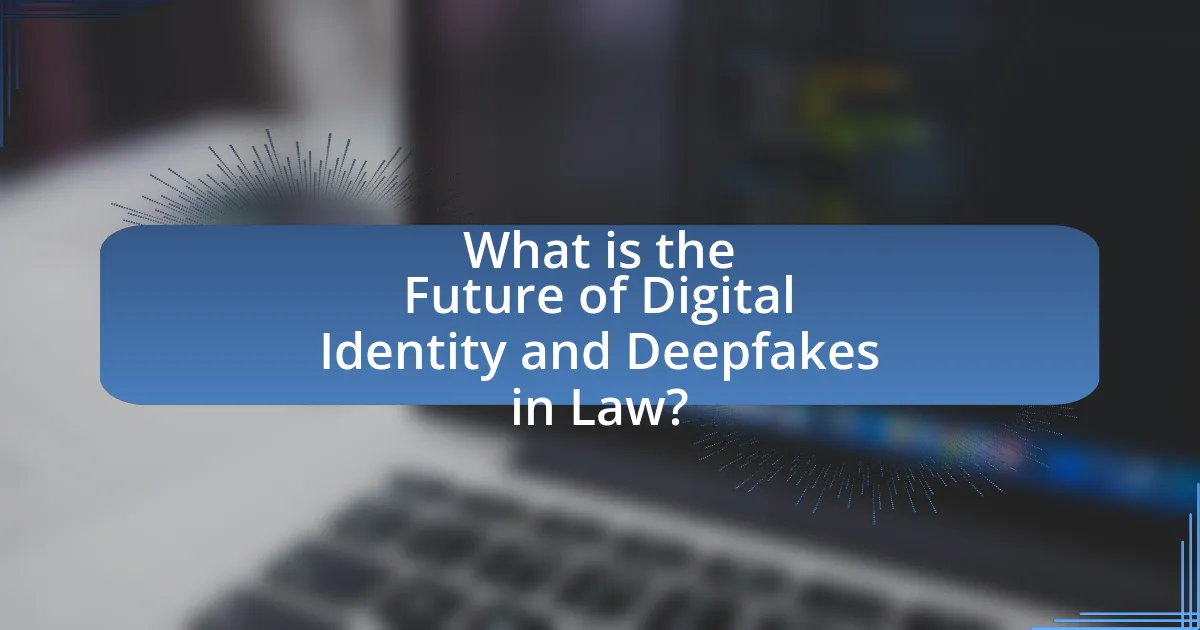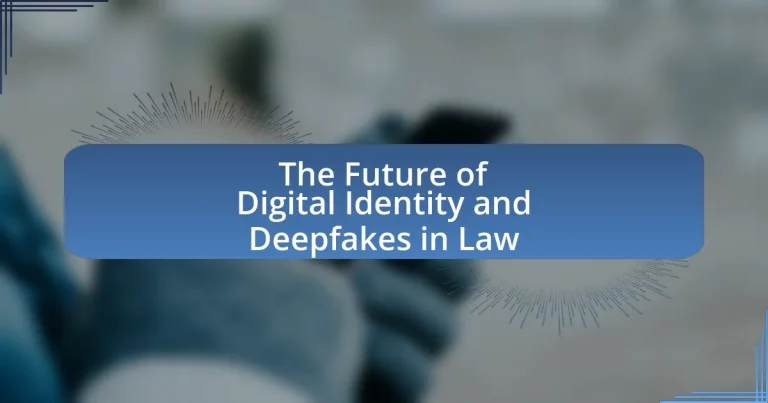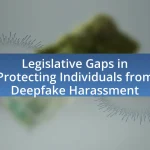The article examines the future of digital identity and deepfakes within the legal framework, highlighting the need for increased regulation to address the challenges posed by these technologies. It discusses the definition of digital identities in law, key components such as personal information and authentication methods, and the impact of deepfakes on authenticity and trust. The article also explores the legal implications of deepfakes, including issues of consent and identity theft, and emphasizes the necessity for evolving legal frameworks to protect individuals’ rights. Additionally, it outlines potential future trends in digital identity verification and legislative changes aimed at mitigating the risks associated with deepfake technology.

What is the Future of Digital Identity and Deepfakes in Law?
The future of digital identity and deepfakes in law will likely involve increased regulation and legal frameworks to address the challenges posed by these technologies. As deepfakes become more sophisticated, they can undermine trust in digital identities, leading to potential misuse in fraud, defamation, and misinformation. Legal systems will need to adapt by establishing clear definitions of identity verification and liability for the creation and distribution of deepfakes. For instance, the introduction of laws like the Malicious Deep Fake Prohibition Act in the United States illustrates a legislative response aimed at curbing harmful uses of deepfake technology. Additionally, advancements in digital identity verification methods, such as biometric authentication and blockchain technology, may provide more secure ways to establish and protect identities in a landscape increasingly threatened by deepfakes.
How are digital identities defined in the context of law?
Digital identities in the context of law are defined as the online representations of individuals or entities that encompass personal data, digital credentials, and online behaviors. These identities are recognized legally as they can affect rights, responsibilities, and liabilities in various legal frameworks, such as privacy laws, cybersecurity regulations, and identity theft statutes. For instance, the General Data Protection Regulation (GDPR) in the European Union establishes guidelines for the processing of personal data, thereby acknowledging the legal significance of digital identities.
What are the key components of digital identity?
The key components of digital identity include personal information, authentication methods, and digital footprints. Personal information encompasses data such as names, addresses, and contact details, which are essential for establishing identity online. Authentication methods, including passwords, biometrics, and two-factor authentication, verify the identity of users and secure access to digital services. Digital footprints consist of the traces individuals leave online, such as social media activity and browsing history, which contribute to the overall perception of one’s digital identity. These components collectively shape how individuals are recognized and interact in the digital landscape.
How does digital identity impact legal frameworks?
Digital identity significantly impacts legal frameworks by necessitating the adaptation of laws to address issues of identity verification, privacy, and cybersecurity. As individuals increasingly engage in online activities, legal systems must evolve to protect personal data and ensure that digital identities are securely managed. For instance, the General Data Protection Regulation (GDPR) in the European Union establishes strict guidelines for data protection and privacy, directly influencing how organizations handle digital identities. This regulatory framework aims to safeguard individuals’ rights in the digital space, highlighting the legal implications of digital identity management.
What role do deepfakes play in the evolution of digital identity?
Deepfakes significantly influence the evolution of digital identity by enabling the creation of hyper-realistic synthetic media that can alter perceptions of authenticity. This technology allows individuals to manipulate their digital personas, leading to both innovative applications in entertainment and serious implications for misinformation and identity theft. For instance, a study by the University of California, Berkeley, highlights that deepfake technology can convincingly impersonate individuals, raising concerns about the integrity of personal identity online. As a result, the proliferation of deepfakes challenges traditional notions of identity verification and trust in digital interactions, necessitating new legal frameworks and technological solutions to address these emerging risks.
How are deepfakes created and utilized?
Deepfakes are created using artificial intelligence techniques, primarily through deep learning algorithms that analyze and synthesize visual and audio data. These algorithms, particularly Generative Adversarial Networks (GANs), enable the generation of realistic images and videos by training on large datasets of existing media. The utilization of deepfakes spans various domains, including entertainment for creating realistic special effects, social media for humorous content, and malicious applications such as misinformation and identity theft. The accuracy of deepfake technology is evidenced by its ability to produce videos that can deceive viewers, as demonstrated in studies showing that deepfake detection remains a significant challenge for current technologies.
What are the legal implications of deepfakes on digital identity?
Deepfakes pose significant legal implications for digital identity, primarily concerning issues of consent, defamation, and identity theft. The unauthorized use of deepfake technology can lead to the creation of misleading or harmful representations of individuals, which may violate privacy laws and intellectual property rights. For instance, in the United States, the use of deepfakes without consent can be prosecuted under various state laws that address harassment and defamation, as seen in California’s law against the malicious use of deepfakes. Furthermore, deepfakes can facilitate identity theft, as individuals may be impersonated in a manner that damages their reputation or financial standing, leading to potential legal actions for damages. The evolving nature of digital identity law necessitates ongoing legislative updates to address these challenges effectively.
Why is the intersection of digital identity and deepfakes significant for the future of law?
The intersection of digital identity and deepfakes is significant for the future of law because it raises critical challenges regarding authenticity, accountability, and privacy. As deepfake technology advances, it becomes increasingly difficult to distinguish between genuine and manipulated digital identities, leading to potential misuse in fraud, defamation, and misinformation. For instance, a study by the Deeptrace Labs in 2019 reported a 100% increase in deepfake videos online, highlighting the urgency for legal frameworks to address these issues. Consequently, lawmakers must develop regulations that protect individuals’ digital identities while ensuring that the legal system can effectively respond to the implications of deepfakes on evidence and personal rights.
What challenges do deepfakes pose to legal systems?
Deepfakes pose significant challenges to legal systems by complicating the verification of evidence and undermining trust in digital content. The ability to create realistic but fabricated audio and video can lead to false accusations, defamation, and the manipulation of public opinion, making it difficult for courts to ascertain the authenticity of evidence presented. For instance, in 2020, a deepfake video of a politician was used to spread misinformation, highlighting the potential for deepfakes to disrupt electoral processes and legal proceedings. This technology also raises questions about liability and accountability, as it becomes challenging to determine who is responsible for the creation and dissemination of harmful deepfake content.
How can laws adapt to address issues arising from deepfakes?
Laws can adapt to address issues arising from deepfakes by implementing specific regulations that define and penalize the malicious use of synthetic media. For instance, jurisdictions can establish legal frameworks that categorize deepfakes as a form of fraud or defamation, thereby allowing victims to seek redress. Additionally, laws can mandate transparency requirements for the creation and distribution of deepfakes, compelling creators to disclose when content is artificially manipulated. Evidence of this approach can be seen in California’s AB 730, which criminalizes the use of deepfakes for malicious purposes, highlighting a legislative response to the potential harms posed by this technology.
What are the ethical considerations surrounding digital identity and deepfakes?
The ethical considerations surrounding digital identity and deepfakes include issues of consent, misinformation, and identity theft. Digital identity is often manipulated through deepfakes, which can create misleading representations of individuals without their permission, violating their right to control their own image. Misinformation arises when deepfakes are used to spread false narratives, potentially influencing public opinion or inciting violence, as seen in instances where fabricated videos have gone viral. Furthermore, deepfakes can facilitate identity theft, where individuals’ likenesses are used to impersonate them for fraudulent activities, undermining trust in digital interactions. These ethical dilemmas necessitate robust legal frameworks to protect individuals’ rights and ensure accountability for misuse.
How do privacy concerns relate to digital identity?
Privacy concerns are intrinsically linked to digital identity as they involve the protection of personal information that defines an individual’s online presence. Digital identity encompasses various data points, including social media profiles, online transactions, and biometric data, which can be exploited if not adequately protected. For instance, a 2021 study by the Pew Research Center found that 81% of Americans feel that the potential risks of sharing personal information online outweigh the benefits, highlighting widespread anxiety over data misuse. This relationship underscores the necessity for robust privacy measures to safeguard digital identities from unauthorized access and exploitation.
What ethical dilemmas arise from the use of deepfakes in legal contexts?
The use of deepfakes in legal contexts raises significant ethical dilemmas, primarily concerning the authenticity of evidence and the potential for manipulation. Deepfakes can create realistic but fabricated audio and video content, which may be used to mislead courts or juries, undermining the integrity of the judicial process. For instance, a deepfake could falsely depict an individual committing a crime, leading to wrongful convictions. Additionally, the challenge of distinguishing between genuine and altered content complicates the legal standards for evidence, as traditional methods of verification may no longer suffice. This situation creates a pressing need for updated legal frameworks and ethical guidelines to address the implications of deepfakes in law.
How can stakeholders prepare for the future of digital identity and deepfakes in law?
Stakeholders can prepare for the future of digital identity and deepfakes in law by implementing robust verification systems and developing comprehensive legal frameworks. These systems should utilize advanced technologies such as blockchain for secure identity management and AI for detecting deepfakes. Research indicates that the use of blockchain can enhance transparency and trust in digital identities, while AI algorithms have shown effectiveness in identifying manipulated media. For instance, a study by the University of California, Berkeley, highlights that AI can achieve over 90% accuracy in detecting deepfake videos, underscoring the importance of integrating such technologies into legal practices. Additionally, stakeholders should engage in continuous education and training to stay updated on emerging threats and legal implications associated with digital identities and deepfakes.
What best practices should legal professionals adopt regarding digital identity?
Legal professionals should adopt best practices such as maintaining strong password protocols, utilizing two-factor authentication, and regularly updating security measures to protect their digital identity. These practices are essential as they mitigate risks associated with unauthorized access and identity theft, which are prevalent in the legal field. For instance, a study by the American Bar Association found that 29% of lawyers reported experiencing a data breach, highlighting the need for robust digital security measures. Additionally, legal professionals should engage in continuous education about emerging threats, such as deepfakes, to stay informed and prepared against potential challenges to their digital identity.
How can individuals protect their digital identities from deepfake threats?
Individuals can protect their digital identities from deepfake threats by employing a combination of awareness, verification tools, and privacy settings. Awareness involves staying informed about the existence and capabilities of deepfake technology, which can help individuals recognize potential threats. Verification tools, such as reverse image searches and deepfake detection software, enable users to confirm the authenticity of videos and images before sharing or believing them. Additionally, adjusting privacy settings on social media platforms can limit the amount of personal information available to malicious actors, reducing the risk of deepfake creation. According to a 2020 report by the DeepTrust Alliance, the prevalence of deepfakes is increasing, making proactive measures essential for safeguarding digital identities.
What are the potential future trends in digital identity and deepfakes in law?
Potential future trends in digital identity and deepfakes in law include the development of more sophisticated verification systems and the establishment of legal frameworks specifically addressing deepfake technology. As digital identity becomes increasingly critical in various sectors, including finance and healthcare, the demand for robust identity verification methods will rise, leading to innovations such as biometric authentication and blockchain-based identity solutions. Concurrently, as deepfakes become more prevalent, legal systems will likely evolve to incorporate regulations that define liability for the creation and distribution of deepfake content, as evidenced by recent legislative efforts in jurisdictions like California and Texas aimed at combating malicious deepfake use. These trends indicate a growing intersection between technology and law, necessitating ongoing adaptation to protect individuals and uphold justice.
How might technology evolve to enhance digital identity verification?
Technology may evolve to enhance digital identity verification through the integration of advanced biometrics, artificial intelligence, and blockchain technology. Advanced biometrics, such as facial recognition and iris scanning, provide unique identifiers that are difficult to replicate, thereby increasing security. Artificial intelligence can analyze patterns and detect anomalies in user behavior, improving the accuracy of identity verification processes. Blockchain technology offers a decentralized and tamper-proof method for storing identity data, ensuring that information remains secure and verifiable. These advancements collectively address the growing concerns around identity theft and fraud, as evidenced by the increasing adoption of biometric systems in various sectors, which have shown to reduce fraud rates significantly.
What legislative changes are anticipated in response to deepfake technology?
Legislative changes anticipated in response to deepfake technology include the introduction of laws specifically targeting the creation and distribution of deepfakes, particularly those that could cause harm or misinformation. For instance, several U.S. states have already enacted laws criminalizing malicious deepfakes, with California’s law making it illegal to use deepfakes to harm or defraud individuals, particularly in the context of elections and pornography. Additionally, federal legislation is being discussed to establish clearer guidelines and penalties for the misuse of deepfake technology, reflecting growing concerns over its potential to undermine trust in digital media and impact public safety.
What practical steps can be taken to navigate the challenges of digital identity and deepfakes in law?
To navigate the challenges of digital identity and deepfakes in law, implementing robust legal frameworks and technological solutions is essential. Establishing clear regulations that define the legal status of digital identities and the use of deepfake technology can help mitigate misuse. For instance, laws that require consent for the use of an individual’s likeness in deepfake content can protect personal rights. Additionally, employing advanced detection technologies, such as AI-based algorithms that identify deepfake characteristics, can assist law enforcement and legal professionals in verifying authenticity. Research indicates that the use of such technologies can significantly reduce the spread of misinformation, as demonstrated in studies by the University of California, Berkeley, which found that AI detection methods improved accuracy in identifying manipulated media by over 90%.


